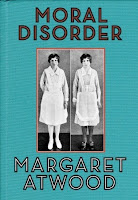I wasn't sure how I wanted to review this book. Margaret Atwood's Moral Disorder is a collection of intertwined short stories. How connected are these stories? Did I want to comment on each story individually (as I like to do with short stories) or do I want to talk about the book as a whole? I decided that I'd do a combination. I have a few sentences for each story, then I'll comment on the book as a whole, which I have to say, I really enjoyed. So here goes:
The Bad News
The Bad News is the first short story in Moral Disorder. It is told from the perspective of an older woman. She seems to be preoccupied with her end and the end of her husband. She repeats the phrase 'not yet'; the things that are coming for her are not yet there. She is more concerned with her life than the deaths in the news. Aren’t we all? Is that the disorder of our morals?
The Art of Cooking and Serving
It is a story about being stuck and escaping. The main character imagines a different future. There is always a sadness when a child is force to grow up too early.
The Headless Horseman
The Headless Horseman examines siblings/sisterhood over the years. I found it very connected to second story.
My Last Duchess
Move on. Do not be a dumb bunny.
The Other Place (vague spoiler)
I know who the girl is. For some reason, I thought she might be the daughter of the old woman, but I'm coming to recognize her voice. Her past isn't just in the lady; it's leaving clues to the future too.
Monopoly
Monopoly is the first story to feel unresolved and like a middle or explanatory chapter rather than a stand-alone story. It was good though, because we learn more about Nell and how she came to be with Tig. So, I appreciated the explanation, not that it felt like an “explanation,” just a chapter in a novel.
Moral Disorder
This was another story that also had a "middle chapter" feeling. Maybe that's just what happens when you put together intertwined short stories. If I read Moral Disorder or Monopoly alone, out of this context, perhaps my feelings would be different.
White Horse
White Horse gives you the feeling of a separate story again, which is nice. We get a good look at Nell and Lizzie as people, their past, present and future. It gives them more dimension.
Entities
Very quick, fast-paced read. I liked that Lillie was the focus. It gave Entities that short story feeling that some of the other stories were missing.
The Labrador Fiasco
The father is Nell’s right? No names are used, so you're left to assume. It gives you the feeling of the book coming to the end, which is appropriate since it's the second last story of the book. It’s very sad, but well crafted and home to some fantastic characters.
Boys at the Lab
On page 205 a comment was made that reminds me of Doctor Who, "bigger on the inside than it was on the outside.” I kind of loved that line. Was that done on purpose? Does Margaret Atwood watch Doctor Who? I hope someone reading this knows what I'm talking about.
Definitely had the feeling of conclusion. I assume that the daughter is Nell, but the main characters are not named. Boys at the Lab is possibly the best story in the entire collection.
Moral Disorder is a fantastic collection of Atwood tales. I did come away thinking that Moral Disorder is part novel, part short story collection. The stories are more than “intertwined” and exist as individual entities to varying degrees. Some definitely have just the feeling of being able to exist on their own. Other stories feel like chapters, though I think part of that feeling comes from the stories being put together in one volume. Moral Disorder contains some interesting, unique characters. I can't believe I waited so long to read it.





No comments:
Post a Comment